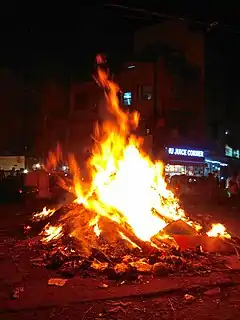| Holika Dahan | |
|---|---|
 Holi Bonfire at Shri Ram Chowk, I.P Extension, Delhi. | |
| Observed by | Hindus |
| Type | Hindu |
| Significance | Victory of righteousness over unrighteousness Incineration of Kamadeva into ash by Shiva |
| Celebrations | Bonfires, celebrations |
| Date | Fourteenth day of the waxing half of the Hindu month Phalguna[1] |
| Related to | Holi |
Holika Dahan (Sanskrit: होलिका दाहन्, romanized: Holikā Dāhana, lit. 'Burning of Holika'), rendered Holika Dahanam in Sanskrit or Choti Holi, is a Hindu festival in which a bonfire is lit to celebrate the burning of the demoness, Holika.[2] This ritual is symbolic of victory of good over evil.[3] It precedes Holi, the festival of colours, which celebrates the spring season.[4] According to legend, Holika was the sister of Hiranyakashipu, who acquired a boon that rendered her invulnerable to fire. She then attempted to kill her nephew, Prahlada, by placing him on her lap in a bonfire. However, she was immolated while Prahlada was saved.[3]
In South India, this occasion is called Kama Dahanam,[5][6] and is associated with the legend of Shiva burning Kamadeva to ashes with his third eye.[7] Pantomimes of Kamadeva are performed on this occasion in rural Tamil Nadu, and his effigies are burnt.[8]
Significance

The night before Holi, pyres are burnt in North India, Nepal, and parts of South India in keeping with this tradition.[9]
In some parts of North India the day is called Holika Dahan. while in other parts like Purvanchal (eastern Uttar Pradesh and western Bihar) as well as Terai regions of Nepal it is called Sammat Jaarna.
References
- ↑ Religious Holidays and Calendars: An Encyclopedic Handbook. Omnigraphics. 1998. ISBN 9780780802582.
- ↑ Galván, Javier A. (2014-06-19). They Do What? A Cultural Encyclopedia of Extraordinary and Exotic Customs from around the World: A Cultural Encyclopedia of Extraordinary and Exotic Customs from around the World. ABC-CLIO. p. 137. ISBN 978-1-61069-342-4.
- 1 2 Lochtefeld, James G. (2002). The Illustrated Encyclopedia of Hinduism: A-M. Rosen. p. 287. ISBN 978-0-8239-3179-8.
- ↑ Gakhar, Roshan (2022-06-17). Human Nature: Love & Happiness. Notion Press. p. 65. ISBN 979-8-88704-336-4.
- ↑ Kumar, Tumuluru Kamal (2015-04-21). Hindu Prayers, Gods and Festivals. Partridge Publishing. p. 54. ISBN 978-1-4828-4708-6.
- ↑ Verma, Rajeev (2009). Faith & Philosophy of Hinduism. Gyan Publishing House. p. 255. ISBN 978-81-7835-718-8.
- ↑ Gopal, Dr Krishna (2003). Fairs and Festivals of India. Gyan Publishing House. p. 344. ISBN 978-81-212-0809-3.
- ↑ Sharma, Usha (2008-01-01). Festivals In Indian Society (2 Vols. Set). Mittal Publications. p. 81. ISBN 978-81-8324-113-7.
- ↑ Singh, S. Harpal (27 March 2013). "Forests bear the brunt of Holi". The Hindu. Retrieved 9 January 2020 – via www.thehindu.com.
